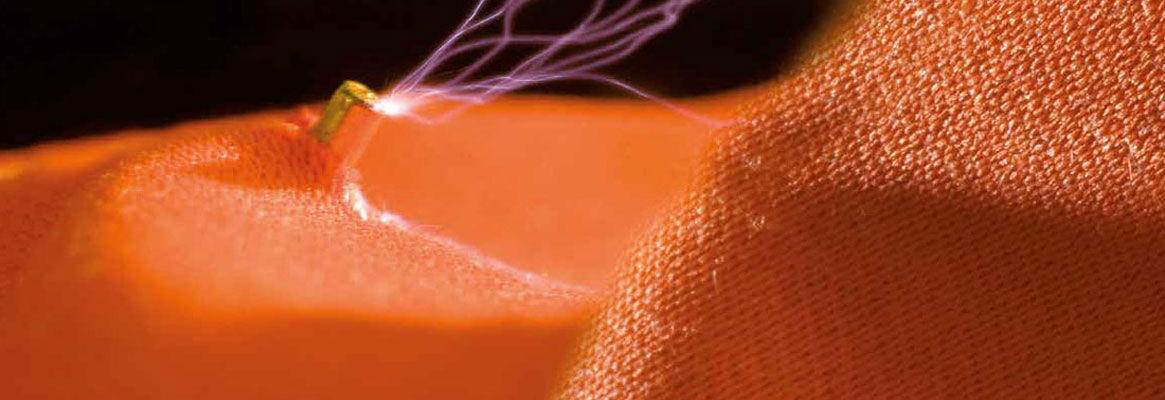e-mail:
Abstract
Depletion of stratospheric ozone is expected to lead to anincrease in the amount of UVB radiation present in sunlight. In addition to itswell-known ability to cause skin cancer, UVB radiation has been shown to alterthe immune system. The immune system is the body's primary defence mechanismagainst infectious diseases and protects against the development of certaintypes of cancer. Any impairment of immune function may jeopardize health byincreasing susceptibility to infectious diseases, increasing the severity ofinfections or delaying recovery from infections. In addition, impaired immunefunction can increase the incidence of certain cancers, particularly cancers ofthe skin.
With careful use of protective clothing, skin damage can bereduced drastically. Medical experts frequently recommend the use of clothingfor protection from UVR. Not all clothing, however, protects equally oradequately.
The base of solution could be SMARTtextiles withirradiance responsible fibre materials. SMART or INTELIGENT materialsrespond to environmental stimuli with particular changes in some variables. Forthat reason they are often also called responsive or adaptive materials.Depending on changes in some external conditions, adaptive materials changeeither their properties (mechanical, electrical, appearance), their structureor compositions, or their functions.
Mostly, SMART materials are embedded in systems whoseinherent properties can be favourably changed to meet performance needs. Theprimary purpose of the proposed work is development of origin method and devicefor measurement of adaptive response on UV-VIS and NIR irradiance. This work iswidely recognized as establishing the fundamental knowledge base for thecreation of variety of new materials as sensors for application to basictextile structures, non-woven, and other related materials and their barrierproperties against UV-VIS and NIR irradiance. Our objective is to use thespecial photo chromic and photo adaptive polymer, which has a response toabove-mentioned part of electromagnetic irradiation.
Introduction
Reversiblecolour changing of some substances is well known effect. Name of this effect ischromism and if the effect is reversible colour change depending ontemperature, name of this effect is thermo chromic. If is colour changeaffected on solution name is solvate chromism, light colour change dependenceis named photo chromism, etc. This reversible colour change we can use asindicator of different stimulation and true colour measurement method we canquantify by this stimulation.
In present time we have on the market protective clothes, which give goodinsulation against hazardous substances and radiation. Obviously is on themarket measuring systems for measuring dangerous substances and itsconcentration, respectively excessive intensity of radiation. On the other sidewe should solve transportation of these measuring systems, stress of actingpersons (firemen, solders, etc.) during theirs actions from reason of weightand dimensions of measuring systems. This problem will solve integrated textilesensors, which will be flexible component of protective clothes. Potentialpossibilities of using textile-based sensors are now intensively studied inLaboratory Colour and Appearance Measurement (LCAM) of Department of TextileMaterials of Technical University in Liberec, Czech Republic. In this study are present textile sensors with colour response on UV radiation and we will present studies of dynamic changes, stability of sensitivity these kinds of sensors. Also willbe present study of moderating these sensors for different part of UV.
Experiment
In our experiment we prepared samples from PET fabric that was coated by five different photo chromic agents. In first part of our experiment we measured colour change dependence on the time of stimulation. For measurement was used spectrophotometer SF 300 UV and Microflash 200d (Datacolor Intenational, USA). Modus of measurement was: SCI without UV and with aperture 20 mm and 5 mm. The samples was exposed in Judge box II (Gretag Magbeth, USA). We used combination of D 65 simulator and UV fluorescent tube. Spectrum of this combination of illumination you can see on the fig.1.
Fig.1
On the following figures num. 2-6 is shown the response remission curves of studied photo chromic pigments:
We decided that for our following experiment, to choose the pigments no. 3 and no. 5. Therefore intensity of colour changes for their response on illumination (was approximately 2025 %R).
In area of intensity of exposition measurement is obviously need to know time and intensity dependency of sensor response. For time dependency study were test samples in following time scale exposed:
A tested photo chromic material was illumined in following time scale:
|
Time of illumination [min] |
0,5 |
1,0 |
1,5 |
2,0 |
2,5 |
3,0 |
4,0 |
5,0 |
10,0 |
During the testing of regeneration were samples exposed 15 minutes and following regeneration in some time scale as during exposition:
|
Time of regeneration [min] |
0,5 |
1,0 |
1,5 |
2,0 |
2,5 |
3,0 |
4,0 |
5,0 |
10,0 |
Next pictures num.7, 8 show the remission curve during exposition and reversion:
There is shown how the minimum is going down with time of exposition and during reversion is going up. Because is relationships between remission and concentration of colorant agent non-linear in colour measurement is obviously used relation between Kubelka-Munk function and concentration, colour change intensity respectively. Colour change intensity that we used was defined as following equation:
In our study we prepare new view on the relationship between intensity and time of exposition, time of relaxation respectively. Name of this new kind of graphs is colour change hysteresis. On the figure no. 9, we can see, that the colour change speed is higher during of exposition than reversion phase.
On fig. 10 is shown relation between light source distance and intensity of colour change for two exposition times and Minolta Illuminance Meter IT10. It stands to reason, that curves for pigment no. 3 are similar to MIM IT 10.
Conclusion
This paper is introducing study of dynamic properties of photo chromic pigments. This study will be followed by experiment with moderating of above-mentioned properties by UV absorbents. We demonstrate the possibilities of textile-based sensors in area identification of radiation intensity.
References:
- Vikov, M.; Vik, M.: Some problems in measurement of UV protective textiles, The 3-rd China International Wool Textile Conference, Xian 26-28 September 2002
- Vikov, M.; Vik, M.: New micro spectrophotometer for measurement of UPF on textile fibre, 6. Dresdner Textiltagung, 19-21.6. 2002 Dresden, Germany
Acknowledgements
This work was supported by the Czech Ministry of Education as research project VCT LN00B090.
To read more articles on Textile, Industry, Technical Textile, Dyes & Chemicals, Machinery, Fashion, Apparel, Technology, Retail, Leather, Footwear & Jewellery, Software and General please visit http://articles.fibre2fashion.com
To promote your company, product and services via promotional article, follow this link: http://www.fibre2fashion.com/services/article-writing-service/content-promotion-services.asp








